
Daviesia, commonly known as bitter-peas, is a genus of about 130 species of flowering plants in the family Fabaceae, and is endemic to Australia. Plants in the genus Daviesia are shrubs or small trees with leaves modified as phyllodes or reduced to scales. The flowers are arranged singly or in groups, usually in leaf axils, the sepals joined at the base with five teeth, the petals usually yellowish with reddish markings and the fruit a pod.
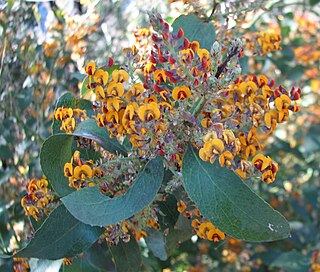
Daviesia latifolia, commonly known as hop bitter-pea, is a shrub in the family Fabaceae. The genus Daviesia is endemic to Australia and the near off shore Islands. Daviesia latifolia is widespread in the Eastern states of Australia. The species was first formally described by botanist Robert Brown, his description published in Hortus Kewensis in 1811.

Daviesia alata is a species of flowering plant in the family Fabaceae and is endemic to south-eastern New South Wales. It is a prostrate to low-lying shrub with winged branchlets that are triangular in cross-section, phyllodes reduced to scales, and orange, red, yellow and maroon flowers.

Daviesia corymbosa, also known as narrow leaf bitter pea, is a species of flowering plant in the family Fabaceae native to the state of New South Wales in eastern Australia. A shrub to 2 m (6.6 ft) high, it grows in sandstone soils in open eucalyptus woodland or heath. It produces showy flowerheads of red and yellow flowers in the spring and early summer.

Acacia pycnocephala is a shrub of the genus Acacia and the subgenus Phyllodineae that is endemic to south western Australia.

Pultenaea largiflorens, commonly known as twiggy bush-pea, is a species of flowering plant in the family Fabaceae and is endemic to south-eastern continental Australia. It is a rigid, erect shrub with narrow egg-shaped leaves with the narrower end towards the base, and bright yellow and crimson flowers.

Daviesia abnormis is a species of flowering plant in the family Fabaceae and is endemic to the south-west of Western Australia. It is an erect, hairy shrub with sharply-pointed, narrow elliptic to narrow egg-shaped phyllodes with the narrower end towards the base, and yellow flowers with faint red markings.

Daviesia nova-anglica is a species of flowering plant in the family Fabaceae and is endemic to northern New South Wales. It is an erect shrub with arching branches, sharply-pointed, egg-shaped to narrow egg-shaped phyllodes, and yellow flowers with red markings.
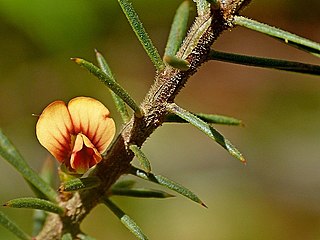
Daviesia acicularis, commonly known as sharp bitter-pea, is a species of flowering plant in the family Fabaceae and is endemic to eastern Australia. It is a small, wiry shrub with tapering, linear phyllodes, and single yellow to orange and dark red flowers.

Daviesia wyattiana, commonly known as long-leaf bitter-pea, is a species of flowering plant in the family Fabaceae and is endemic to eastern Australia. It is a sparse, erect shrub with long, linear phyllodes, and groups of four to seven yellow flowers with red or purplish markings.

Daviesia umbellulata is a species of flowering plant in the family Fabaceae and is endemic to eastern Australia. It is a slender shrub with egg-shaped or linear phyllodes, and groups of up to six yellow to orange flowers with maroon markings.
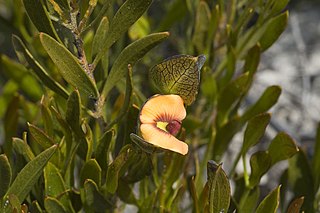
Daviesia alternifolia is a species of flowering plant in the family Fabaceae and is endemic to the south-west of Western Australia. It is a dense, spreading shrub with scattered, egg-shaped phyllodes with the narrower end towards the base, and orange and red flowers with a greenish-yellow centre.
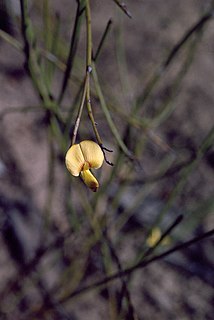
Daviesia anceps is a species of flowering plant in the family Fabaceae and is endemic to the south of Western Australia. It is a dense, erect or low-lying shrub with its branchlets reduced to flattened cladodes, and yellow flowers with red markings.
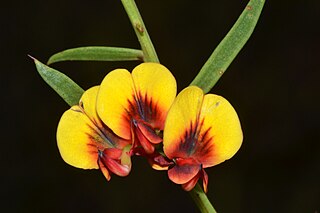
Daviesia angulata is a species of flowering plant in the family Fabaceae and is endemic to the south-west of Western Australia. It is an erect, spreading shrub with prickly, flattened phyllodes, and yellow flowers with red markings.

Daviesia apiculata is a species of flowering plant in the family Fabaceae and is endemic to the south-west of Western Australia. It is an erect, bushy shrub with scattered, erect phyllodes with a point on the end, and yellow flowers with a red tinge.

Daviesia arborea, commonly known as golden pea or bitterleaf pea, is a species of flowering plant in the family Fabaceae and is endemic to eastern Australia. It is a shrub or small tree with weeping branches, linear phyllodes and yellow flowers with red markings.

Daviesia arenaria, commonly known as sandhill bitter-pea, is a species of flowering plant in the family Fabaceae and is endemic to south-eastern continental Australia. It is usually a hummock-forming shrub with many short, spiny branchlets and heart-shaped to elliptic phyllodes with a sharp point on the end, and orange-pink, maroon and yellow flowers.
Pultenaea indira is a species of flowering plant in the family Fabaceae and is endemic to the south-west of Western Australia. It is an erect or low-lying shrub with plate-like or fissured bark near the base, densely hairy stems above, linear to lance-shaped leaves with the narrower end towards the base, and yellow, red and maroon flowers.
Daviesia arthropoda is a species of flowering plant in the family Fabaceae and is endemic to Central Australia. It is a glabrous shrub with widely spreading branches, sharply-pointed, narrowly egg-shaped phyllodes with the narrower end towards the base, and yellow flowers with faint red markings.

Daviesia articulata is a species of flowering plant in the family Fabaceae and is endemic to the south-west of Western Australia. It is a rigid, low-lying or erect shrub with scattered, tapering, cylindrical and sharply pointed phyllodes, and yellow and red flowers.


















